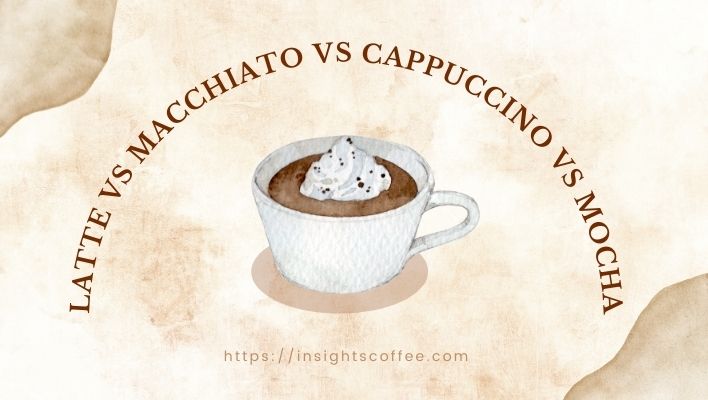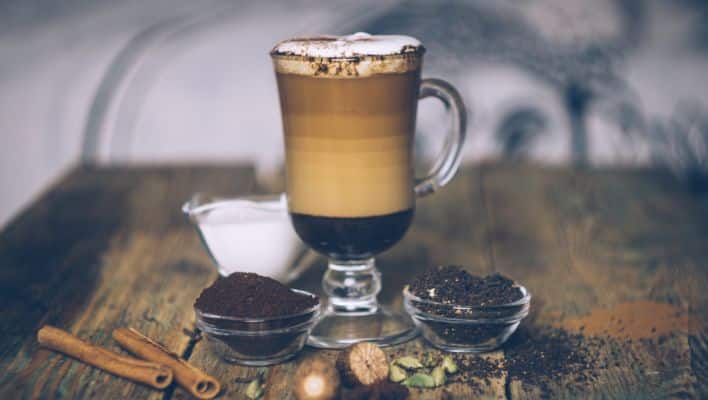Greetings, Espresso Lovers!
If you’ve ever wondered why cappuccino, Latte, macchiato, and Mocha are so popular and what the differences are, this article is for you. In fact, if you’re not an espresso drinker, it’ll be challenging to feel the difference between them right away.
The popularity of these traditional coffee bar beverages has steadily increased in recent years. Simultaneously, the number and variety of local café bars have increased too. Each coffee shop has its uniqueness, history, tradition, and various café drinks. So, if you go to a local café, you’ll have a lot of alternatives from which to choose your favorite beverage. However, the traditionally brewed espresso drinks Macchiato, Latte, Cappuccino, and Mocha are the main attractions within these cafe beverages.
Sometimes You may notice subtle variances between these four drinks, but their texture and flavors are enormously different. In this post about Latte Vs Macchiato Vs Cappuccino Vs Mocha, you will learn everything you need to know about their differences. I’ll go over the differences in-depth to quickly figure out what exactly you’re looking for.
The Essential Ingredients of Latte, Macchiato, Cappuccino, and Mocha
Every cafe drink is prepared with three essential ingredients espresso, steamed milk, and milk foam. Although these three ingredients are used in these four drinks, there are mainly differences in the proportions between their uses. In below, I’ve described the details of Each component.
Espresso is the primary component in Cappuccino, Latte, Mocha, and Macchiato drinks. It is made with coffee beans as the main ingredient, like all other coffee drinks. The only variation is the size of the coffee ground, which implies fine ground coffee is better for Espresso. Espresso can be prepared using either a manual espresso maker, such as a Moka Pot, or an automatic. However, the Automatic Espresso Maker produces the best Espresso. Espresso is made with high-pressure steam that allows water to pass through densely packed coffee grinds, resulting in a small amount of thick liquid known as an espresso shot. All café beverages start with these espresso shots. On the other hand, Espresso has a substantially higher caffeine level than regular coffees.
The next ingredient in cafe drinks is steamed milk. Most espresso machines come with a steaming wand like a long metal tube to prepare it. Baristas are often steaming milk in metal containers/carafes with the help of this steaming wind.
The final element is milk foam, which is found in most cafe drinks. Skilled baristas can make it by using a stick to whip the steaming milk in the carafe gently. A velvety structure is created on the Latte using milk foam with fine bubbles. On the other hand, Cappuccino uses dried milk foam with large bubbles.
Above all, a trained barista needs a top-quality espresso grinder and an espresso machine with a steam wand to prepare high-quality Espresso.
Appliances Required for Brewing
Espresso Machine;
Milk Frother;
Coffee Grinder;
What is Latte?
Latte is an elite and classic beverage for coffee lovers, and the name originally derives from the Italian word Caffe latte or caffè e latte. Straightly, Latte is an Italian coffee drink made from coffee and steamed milk.
The ideal ratio for a 180ml cup is 30ml Espresso, 120ml steam milk, and 30ml milk foam. However, outside Italy, it is made in 240ml cups with a single (30ml) or a double (60ml) Espresso shot and steam milk with a 12mm thick milk foam layer on top. In today’s popular version of the Latte, the top milk foam layer is perfect for providing an aesthetic design where skilled baristas are often seen creating a beautiful layout.
How to prepare a regular Latte?
To begin, pour one Espresso Shot into the cup or glass that will be used to prepare the Latte. You must steam the milk in a carafe with the help of a steam wand or frothier to microfoam it. To make microfoam, froth the milk until there are no visible bubbles in the milk, and it sticks to the carafe when you swirl it by hand. The next step is to pour the hot milk into the espresso slowly and softly. Finally, the expert baristas produce a lovely pattern on the Latte’s top layer that is commonly seen in cafés.
What is Macchiato?
The name comes from the Italian word macchiato, which means “stained.” This popular beverage is known as Caffè macchiato, but it is also called Espresso macchiato. The term “caffè macchiato” literally means “stained coffee” or “spotted coffee.”
Caffè macchiato has a higher proportion of Espresso than any other beverage made with milk and Espresso. This beverage is prepared by mixing 90% espresso with 10% steam milk in a standard cup(60ml-90ml).
How to prepare a regular Macchiato?
A macchiato is similar to a latte in terms of preparation. In a nutshell, it’s served in a small coffee cup but a bit larger than an espresso cup. The espresso shots are first taken in the cup, and steam the milk with the help of a steam wand or milk frother. The milk in Macchiato is made a bit foamier than in Latte. A ball of milk foam is required to prepare a traditional Macchiato. Many baristas like to top off their macchiatos with additional milk. That’s why the flavor differs from cafe to cafe. Once the espresso shot is taken in the cup, pour the milk foam of your choosing.
What is Cappuccino?
Cappuccino is another popular espresso drink that started in Austria. It was later popularized and developed in Italy, which is made with steamed milk foam.
It’s usually prepared in a 1: 2: 2 ratio, as recommended by the INEI (Istituto Nazionale di Espresso Italiano), but outside of Italy, it’s prepared with a 1:1:1 ratio espresso shot and steamed milk with a top layer of milk foam. Traditionally, a standard Cappuccino cup is between 150 and 160 ml in size with the milk foam.
How to prepare a regular Cappuccino?
Cappuccino cups or mugs are comparable in size to Latte cups. However, in certain cafés, they are served in somewhat smaller (bigger than espresso cups) mugs. The recipe is comparable to a 1: 1: 1 espresso, steamed milk, and milk foam; however, some prefer a 1: 2: 2 ratio. Only a cappuccino has a higher milk foam concentration than a latte.
What is Mocha?
Café Mocha is actually another form of Café Latte, also called Mochaccino. It originated in the town of Mocha in Yemen, one of the earliest centers of the coffee business. It is basically a chocolate-flavored warm espresso drink served in a glass instead of a cup, which is sometimes considered a dessert.
Like Café Latte, it is prepared by combining steamed milk with Espresso, but with cocoa powder and sugar added for chocolate flavor and sweetness. It’s a type of coffee beverage you can consider as a dessert.
There is also a mocha latte with a slightly different ratio of ingredients than the Mochaccino. Mochaccino is prepared with 2/5 espresso, 2/5 Hot Chocolate, and 1/5 steamed milk. But, Mocha Latte includes 1/8 Espresso, 1/8 hot chocolate, 5/8 Eighths Steamed milk, and 1/8 whipped cream.
How to prepare a regular Mocha?
Mocha is made by following Latte’s recipe, including the addition of chocolate. The size of the mug is similar to Latte’s, so it can be seen serving in identical cups in cafes. Each café has its unique way of making Mocha, some using sweet chocolate syrup and some mixing hot water with cocoa powder. Again, chocolate syrup is utilized before or after the espresso shot somewhere. In any case, a Mocha drink can be made in the same way as a latte and topped with whipped cream, chocolate, or milk foam.
Infographic on Latte Vs Macchiato Vs Cappuccino Vs Mocha
Already, I’ve made an infographic outlining the distinctions between these four espresso beverages, which will help you better comprehend the topic. Despite the fact that the infographic is self-explanatory, I’ve broken out the facts in this article. Let’s have a look at the infographic:

Share This Image On Your Site
At a glance Latte Vs Macchiato Vs Cappuccino Vs Mocha
| Difference | Latte | Macchiato | Cappuccino | Mocha |
|---|---|---|---|---|
| Ingredients | Espresso, Steamed Milk, Milk Foam | Espresso, Steamed Milk | Espresso, Steamed Milk, Milk Foam | Espresso, Chocolate, Steamed Milk, Milk Foam, Whipped Cream |
| Ratio | 1:4:1 | 9:1 or 2:1 | 1:1:1 or 1:2:2 | 2:2:1 or 1:1:5:1 |
| Volume | 240-480ml | 60-90ml | 240-480ml | 240-480ml |
| Espresso Shot | Single or Double | Double | Single or Double | Single or Double |
| Calories | 206/480ml | 13/60ml | 130/480ml | 359/480ml |
| Caffeine | 173mg/480ml | 85mg/60ml | 173mg/480ml | 200mg/480 ml |
| Origin | Italy | Italy | Austria, Italy | Yemen |
| Flavor | Mild with milk flavored | Strong | Strong | Sweet |
Final Words
Despite the fact that there are several variations of latte and macchiato, they always contain the same basic ingredients of espresso and milk. Each drink is distinguished by its technique of preparation. Similarly, while cappuccinos and mochas come in a variety of flavors, they always include the same basic ingredients: espresso, milk, and chocolate. As everyone has different tastes and preferences, it’s important to understand the basic differences.
In a nutshell, describing coffee drinks in depth is a challenging endeavor. The most considerable distinction between the four espresso beverages is their flavor, and the ratio of ingredients, even though there isn’t much difference between them. I recommend that you try all of the drink samples to determine which one is right for you.
Latte or Cappuccino are good choices if you enjoy milk in your coffee. Macchiato is the ideal choice if you want a strong-flavored coffee, while Mocha e is the best choice for sweet chocolate-flavored coffee.
In conclusion, the concept behind all these beverages is essentially the same. The most important thing is that you enjoy your drink. So whatever you choose to drink, make sure you enjoy it!
Don’t forget to leave a comment below if you have any questions or recommendations about this topic.



1 thought on “Latte Vs Macchiato Vs Cappuccino Vs Mocha: What is The Difference?”